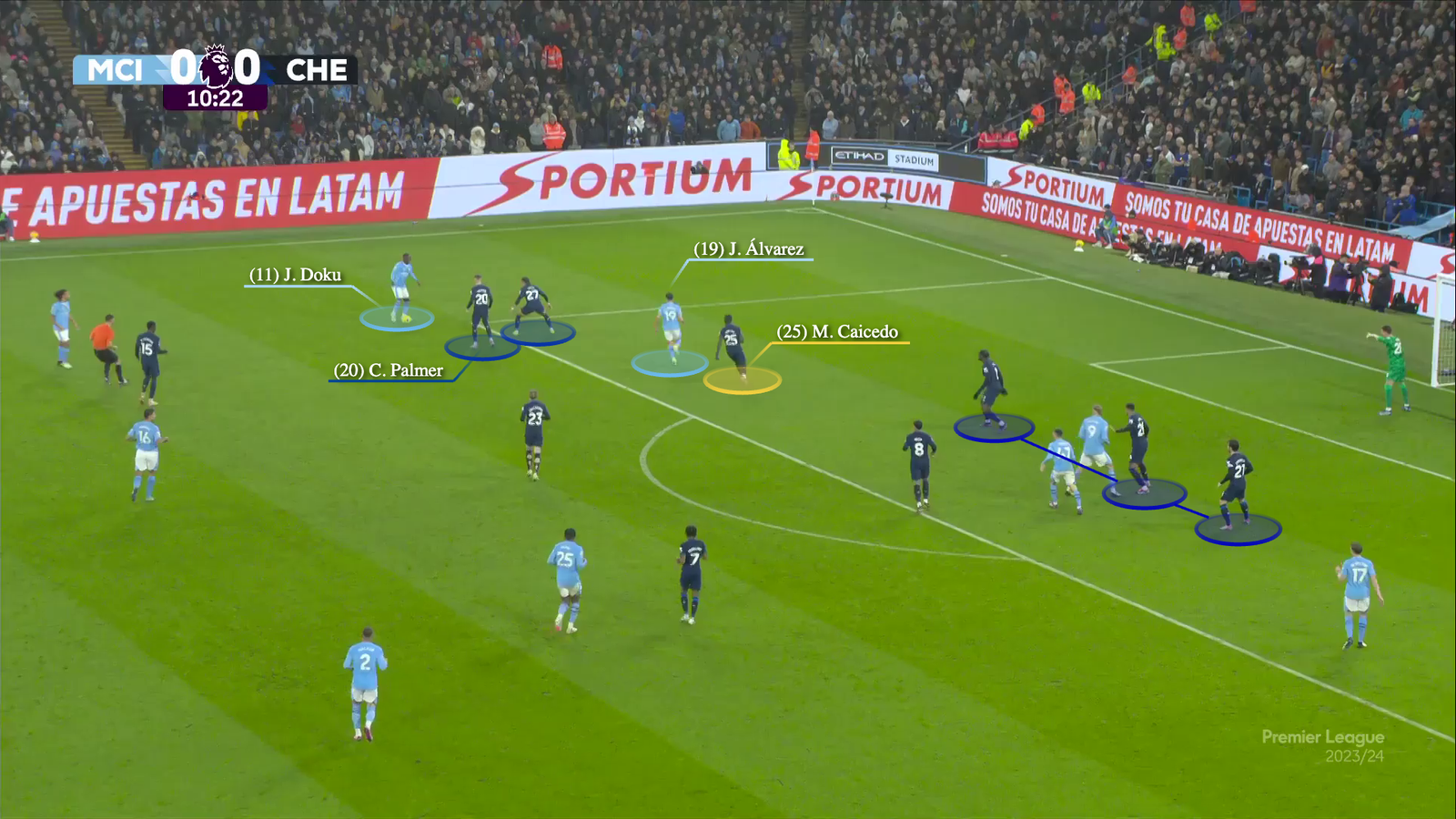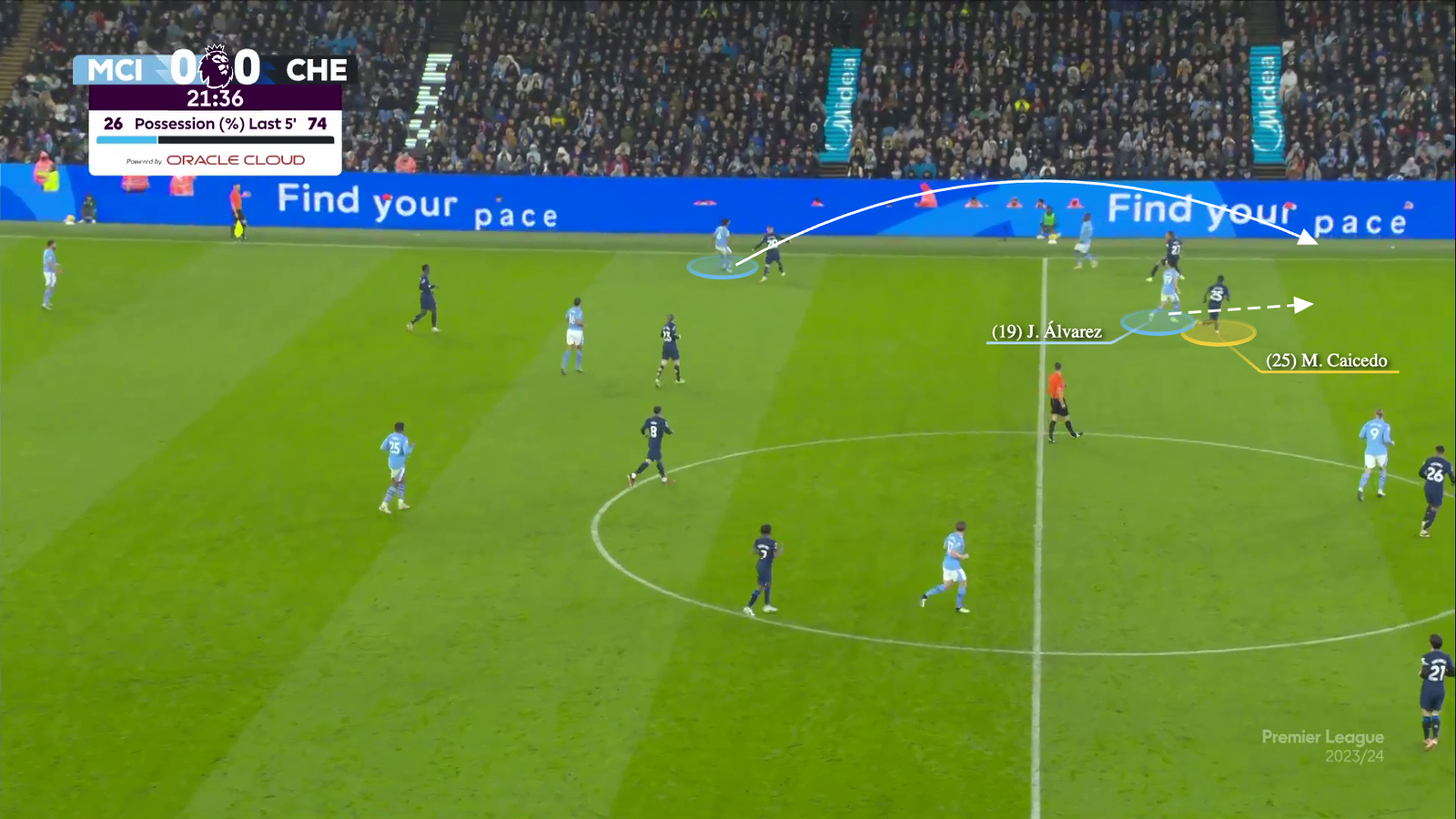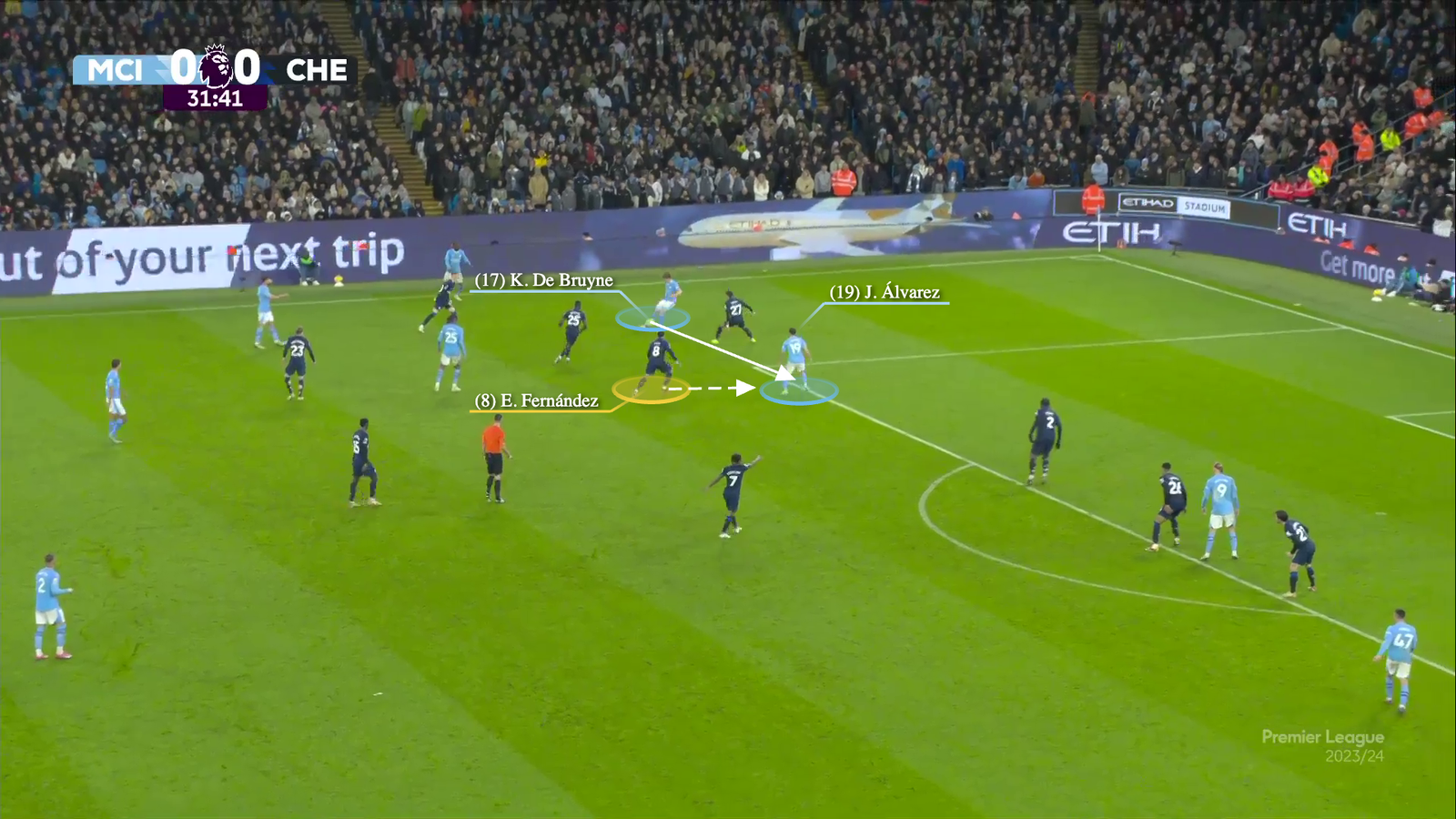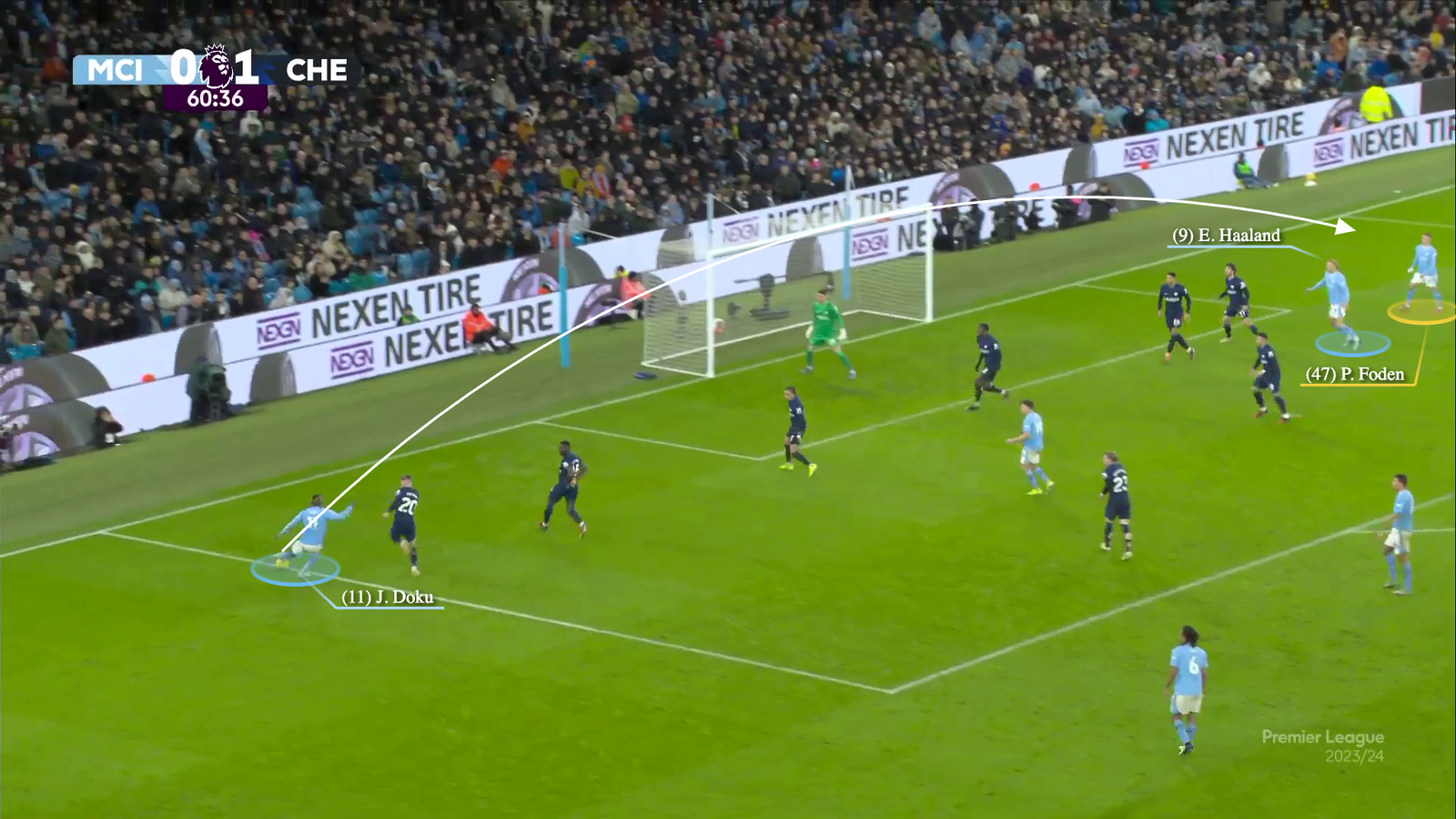When a team performs below their normal standards, questions are often asked about the manager’s decisions and the players’ output. Yet, it takes two sides to play a game of football.
The opponent’s level could be one of the reasons a certain team aren’t as good as usual on a given day. “It’s in general, when you perform like this always there are many reasons, not just one,” said Manchester City manager, Pep Guardiola, when he was asked about his team’s performance in the first half of their 1-1 home draw against Chelsea on Saturday. “Also, we can say that Chelsea played really good.”
City’s lack of tempo and rhythm as they tried to play through Chelsea’s defensive block was clear in the first 45 minutes, but this wasn’t only about Guardiola’s side. Chelsea’s defensive organisation made things harder for a City forward unit that was composed of five direct attackers in Jeremy Doku, Julian Alvarez, Erling Haaland, Kevin De Bruyne and Phil Foden.
As is customary, City’s shape on the ball morphed into a 3-2-4-1, with Manuel Akanji pushing up into midfield, and Alvarez and De Bruyne playing as attacking midfielders between Chelsea’s lines. Theoretically, City’s five-versus-four in the last line should have caused their visitors some problems, but Guardiola’s opposite number, Mauricio Pochettino, had multiple answers to that.
First, Cole Palmer constantly dropped to double up with Malo Gusto against Doku down City’s left wing. Right-back Gusto’s aggressive defensive position created space between him and right centre-back Axel Disasi…

… but that was covered by Moises Caicedo, who regularly dropped into the right half-space to track Alvarez’s runs, as Palmer and Gusto defended against Doku. Caicedo’s role also meant the rest of Chelsea’s back four didn’t need to shift across, making them ready to defend the switch of play, in case City moved the ball to the other side.

In this example, City are trying to advance down their left wing, but Gusto’s aggressive positioning prevents Nathan Ake from playing the ball directly to Doku. The role of City’s ‘No 10’ — Alvarez here — in these situations is to try to attack the space between the opponent’s right-back and right centre-back…

… but Caicedo’s presence means that when Ake tries to play the ball into the path of Alvarez…

… the Ecuador midfielder intercepts it and halts City’s attack.

On the few occasions when De Bruyne roamed to overload the left side, Enzo Fernandez reacted by moving closer to support Caicedo and Gusto.

Here, Ruben Dias plays the ball to De Bruyne, with Caicedo caught between marking Akanji (No 25) and dropping deeper to deal with the Belgian.

De Bruyne plays a one-touch pass to Alvarez, but Fernandez’s proximity allows him to pressure the Argentinian and Disasi clears to start a counter-attack.


In another example, De Bruyne moves to the left side after a City free kick and tries to find Alvarez’s run behind Caicedo and Gusto, but Fernandez is again in the correct position to cover the space…

… and prevents Alvarez from having a shot on target. This block from Fernandez started the Chelsea counter-attack that ended with Raheem Sterling scoring the game’s opening goal.

City’s slow movement of the ball from one side to the other, which was further hindered by Conor Gallagher shadowing Rodri and blocking passes to the Spanish midfielder, allowed Caicedo and Fernandez to shift across the pitch in time to defend the required spaces.

In the second half, Chelsea continued with their defensive approach: Palmer supporting Gusto, Caicedo protecting the space between the right-back and Disasi, and Fernandez ready to move across to assist.

However, City’s approach in the final third shifted towards focusing more on attacking the back-post area, instead of trying to break down Chelsea’s defensive block.

Haaland positioning himself towards the back post helped City’s widest player in these situations. Here, Foden is furthest out on their right side when Doku tries to dribble past Palmer on the other…

… before putting a cross towards the back post. Haaland’s presence occupies Ben Chilwell and creates more space for Foden…

… whose shot is half-cleared by Disasi, and only Levi Colwill’s block stops Haaland from scoring.


In the 71st minute, Pochettino moved to a clearer back five, with Trevoh Chalobah coming on for Palmer. Three minutes later, Guardiola instructed Kyle Walker to push forward down City’s right wing, Akanji to drop deeper and Foden to move inside. As a result, De Bruyne moved into a free role in midfield, next to Rodri.

The change in the positioning of these City players meant they could sustain the threat of the front line, while still having De Bruyne’s creativity. Here, the Belgian tries to find Haaland, who is initially positioned towards the back post and isolated against Colwill because Chilwell is keeping an eye on Walker (out of shot)…

… but the striker’s header misses the target.

Four minutes later, De Bruyne drives through a space in Chelsea’s midfield and finds Bernardo Silva, who had replaced Alvarez.

Before Bernardo crosses the ball to the back post, Haaland adjusts his position and moves towards that area, occupying Chilwell…

… and allowing Walker a free run at the ball. The England full-back’s shot is blocked by Disasi and it falls to Rodri…

… whose strike finds the net after deflecting off Chalobah.

City’s performance in the first half wasn’t up to their standards and, in hindsight, Chelsea fans might have wanted their team to drop deeper later in the game instead of doing that with 19 minutes to go. However, these weren’t the only factors in the match ending as a draw.
Chelsea’s defensive organisation, their threat on counters and how they built up the attack down their right side through Palmer are the positives Pochettino will look at. Similarly, Guardiola will be pleased with City finding a solution in the second half in the form of crosses towards the back post, which were aided by his in-game tweaks.
Even if you are performing at your normal levels, sometimes the other team might just be doing the right things.
Read the full article here


